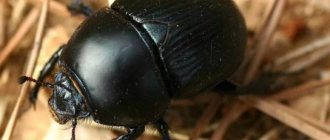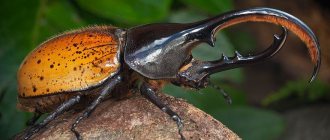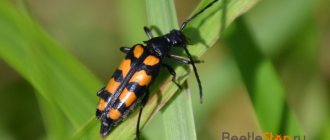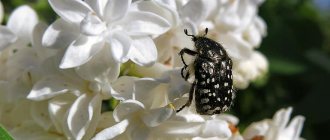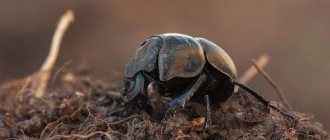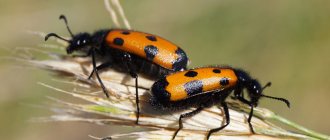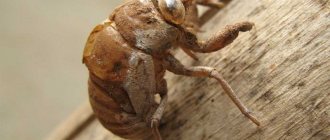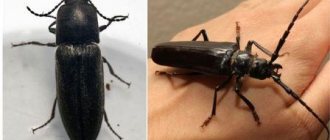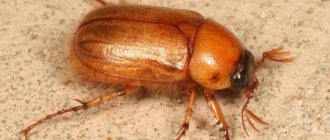Home page Wildlife Animal world
45 905 4.56 3
On the plains of the African continent, where many herbivores live, including many large mammals, there is always food for beetles. The same elephant eats about two hundred and fifty kilograms of food a day, and after a while returns it back in the form of huge dung heaps. We can say that Africa (and other places on our planet) has not yet become bogged down in a huge layer of dung only thanks to the huge number of dung beetles, among which the sacred Egyptian scarab beetle occupies a special place.
Appearance
There are about 100 varieties in total. Egyptian scarab beetles have a black carapace and range from 1 to 4 cm in length. The body has a wide and oval shape, covered with chitin (a durable covering). Young individuals have a matte color, old and worn ones have a shiny color.
The abdomen and legs are covered with dark brown hairs and fluff. Males are distinguished by a bright red fringe with a golden tint, located on the inside of the hind legs. On the head of the scarab beetle, a transverse shape is located with a clypeus with teeth. The front legs are also equipped with teeth.
Where does he live?
You can meet the scarab in:
- Europe;
- Asia.
Beetles live in the African desert.
The insect has taken root in the Eastern Hemisphere. The largest number of individuals live in Africa. The scarab is periodically transported to various countries, which accidentally ended up in manure. However, the scarab does not take root in this case. The insect dies almost instantly.
Nutrition
The main diet is excrement of cattle and horses. He loves horseback the most. He willingly rolls it into balls of different sizes, then buries it in the ground for later use as food.
The scarab beetle feeds on a dung ball until it completely eats it, all this time it lives in the place where it was buried. These balls are created only from fresh manure before it dries out. The beetle can also eat decomposed organic products. Rotten leaves, flowers and grass.
Life cycle
The female and male, having met on a pile of dung, make a joint ball and then dig a hole, which ends in a nesting chamber. Mating takes place there, after which the male usually leaves the nest, and the female begins to produce 1-3 pear-shaped dung ovoids. Then she lays one egg in them. Fertilized females are capable of digging more than a dozen burrow nests during the active period.
The egg stage lasts 5-12 days, after which the larvae hatch. They feed on food stored by their parents and after about a month, having gone through 3 phases of development, they pupate. After 2 weeks, young beetles emerge from the pupae and remain inside the ovoids for a long time until autumn or spring rains soften the cocoon. In mid-latitudes, scarabs overwinter inside ovoids.
Reproduction
Before mating, a couple of the opposite sex begins to prepare food for future use, for the offspring. First, Egyptian scarab beetles dig deep holes (from 10 to 30 cm) with their paws. After digging, the male crawls away, but the female remains.
She sculpts oval shapes from the dung for each egg separately. Then she makes a hole in each dung ball and lays an egg there. After this, the entrance to the hole is covered.
Sandy soil nurses
The scarab beetle belongs to the class of insects, the order of Coleoptera of the lamellar family, one of the characteristics of which is a special form of antennae structure, which is characterized by a lamellar-shaped pin that can open in the form of a fan.
Currently, scientists have discovered more than a hundred representatives of this genus living in arid areas with sandy soils: deserts, semi-deserts, dry steppes, and savannas. Most are found only in tropical Africa: about twenty species live in the Palaearctic (the region that covers Europe, Asia north of the Himalayas, and North Africa to the southern border of the Sahara), while they are completely absent in the Western Hemisphere and Australia.
Enemies
Due to the fact that it is very noticeable and slow, it is an easy prey for birds and some mammals. It is hunted by crows and small mammals (moles, hedgehogs and others). Foxes eat them in large numbers.
But there is a more dangerous enemy. This is a tick that is capable of breaking through the protective chitinous layer in order to drink all its blood. It often happens that one scarab beetle is attacked by several mites at once.
Benefits and harms for humans
The scarab beetle is not dangerous to humans: it will not attack or spoil food supplies or plants. On the contrary, by recycling organic residues, it helps enrich the soil with minerals and prevents the development of parasites in them, not to mention the specific smell of manure.
The tunnels that the insect prepares for its offspring become a kind of lungs for the soil, providing oxygen access to the roots of plants. For the Egyptians, the scarab beetle is a symbol that maintains the connection between the Sun God and people. It is believed that the insect accompanies a person in earthly and afterlife, signifying sunlight in the heart.
While the Egyptian is alive, the Sacred Scarab attracts good luck, gives longevity and prosperity, protects against evil spirits and brings a good harvest. After death, the insect helps to find a new life, since the religion of the Egyptians is based on the immortality of the soul. Even today, especially religious residents of Egypt place a figurine of a scarab made of ceramic, metal or glass into the burial.
In ancient times, the people of the banks of the Nile had a tradition of mummifying noble persons, then in place of the extracted heart they put a small scarab made of precious metal and decorated with stones. The tradition is associated with the understanding that the heart is the main organ of human life, therefore the ancient scarab beetle was called upon to help the germ of a new life.
Modern Egyptians, with the development of science and medicine, began to regard death as inevitable, but the symbol of the scarab did not disappear from their lives. It is believed that images and figures of a beetle rolling its ball bring good luck to students - after all, the insect creates an ideal geometric shape from waste, while working hard.
It helps creative people achieve their goals, create and turn the simplest things at first glance into works of art. For women, the scarab is the keeper of unfading beauty and longevity, because it was originally considered a symbol of life.
For the stronger sex, it brings recognition from colleagues and high financial inflows. The Egyptians firmly believe that desecration of the symbolism of the scarab by representatives of a different faith entails the wrath of higher powers, up to and including a mortal curse.
Egyptian mythology, symbol, meaning
The scarab beetle is a symbol of Egypt. According to legend, it resembles the path of the Sun, and was born from the desert sands. In ancient times, the Egyptians associated it with the symbol of solar power, and with rebirth in the afterlife.
Even the mythological creator, the world and the man of God in ancient Egypt were depicted with the head of the Scarab Beetle. In Egypt, many sculptures, amulets and decorations in the form of a sacred beetle have been preserved. His images are found in tombs, sculptures and other historical structures.
Scarabs extract moisture from the fog. He stands against the wind and spreads his wings. After a certain time, moisture appears on the high parts of the scarab beetle's head, collecting in a drop. Then this drop flows directly into his mouth. During flight, the wings do not fully open, which violates all the laws of aerodynamics. Makes a masterly flight that even a bird would envy.
The scarab beetle amulet with its image has the ability to protect the owner from evil forces, negative circumstances, create harmony in energy, and give self-confidence.
Lifestyle and habitat
Traditionally, it is believed that the scarab beetle lives in Egypt, but it is distributed throughout the African continent and Western Europe, and it is not uncommon to encounter the insect in these places.
On the Crimean Peninsula, the beetle also catches your eye, but it is much smaller than the Egyptian one. In Russia, the scarab settles in the territories of Dagestan and Georgia, small populations are found in the lower reaches of the Volga.
Individual individuals have been spotted in France, Arabia, Greece and Turkey - where the climate is mild and the summers are long and hot.
An interesting fact is that scientists have been trying to detect traces of scarabs in Australia for more than 20 years, but not a single representative of the species was found, from which it was concluded that these beetles do not like being in the vicinity of kangaroos.
You can see the scarab from mid-April until the onset of cold weather. The insect is active during the day, but at night, if it is not yet warm enough, it can burrow deep into the ground. When it gets hot during daylight hours, the beetle switches to a nocturnal lifestyle.
The scarab is called the soil orderly, because its entire life is centered around the biological waste of animals. Several thousand beetles are able to dispose of a pile of manure in an hour, before it has time to dry out.
External signs of a dung beetle
The color of the dung beetle's shell can be different: green, completely black, blue-green, black-green, black-blue. Regardless of the primary color, they all have a metallic sheen that shimmers in the sunlight. As for the lower part of the body, it is always the same shade. Entomological scientists affectionately call it violet blue, comparing it with the color of the eyes of a fairy-tale queen. There are several scattered dots on the chest shield of these beetles. The elytra, each with 14 grooves, have black thin hairs. The outer part of the upper jaws appears rounded. The total body length of the dung beetle ranges from 16 to 27 mm.
What is included in the diet
In ancient times, the Egyptians believed that the scarab was a cannibal. The beetle crawls under the skin and begins to eat a person from the inside, destroying all organs. Naturally, this is a myth.
Beetles do not feed on flesh. Insects are completely safe for humans and animals. The representatives are classified as orderlies. In an hour, 4 thousand dung beetles destroy a pile of manure. Scarabs are voracious.
The beetles begin to crawl out as soon as the air warms up. At first, insects lead a diurnal lifestyle, and then crawl to the surface only at night. In order to live for 14 days, the scarab requires one large ball of dung.
The insect rolls the food ball into a pre-dug hole. After the pair appears, the beetles make the preparation together.
Beetles prepare dung balls
Food is prepared as follows: a small piece of cattle feces serves as the base; With the edge of its head, the insect cuts off the required amount of feces; The beetle forms balls with its front and hind legs; With its middle legs, the insect firmly holds the feces until the ball is formed.
The balls are stored in a shelter in a dark and cool place. When transporting food, the insect makes sure that other representatives do not take the prey.
Sometimes the ball can be taken away by larger relatives. Therefore, when transporting the beetle, it must be extremely careful. Not only further nutrition, but also procreation depends on the preparations. Like other dung beetles, the insect lays larvae in a round piece of dung. The larvae feed on manure prepared by the female until they mature.
The magical properties of talismans with the image of a scarab
In ancient times, the scarab was depicted everywhere. It can be found on historical monuments that have survived to this day.
This is evidenced by the following found during archaeological excavations:
- Household items of the ancient Egyptians.
- Jewelry.
- Carved boxes.
- Prints and much more.
More often, the figures were made of green stone (this color traditionally symbolized rebirth) and were accompanied by phrases about resurrection in the afterlife.
In honor of the scarabs, statues were erected and installed in an accessible place.
According to legend, anyone who wants to succeed in a serious matter must, after making a wish, walk around the statue seven times, touching its side after each circle.
This guaranteed the fulfillment of a desire, only the goal had to be large-scale - the beetle did not fulfill small requests.
Many modern lovers of the occult believe that the scarab helps not only in the afterlife, but also in real life.
It is assumed that the meaning of a scarab talisman for its owner is enormous.
By purchasing such an amulet, a person will provide himself with:
- Protection from the negative effects of evil spirits.
- Immunity against negative energy and energy vampires.
- Achieving financial stability.
- Help in finding love.
- Harmony in family relationships.
- Infertility treatment.
- Rejuvenation.
- Luck in business.
- Increased libido.
In addition to these main qualities, the amulet has less pronounced additional ones. An amulet with a scarab is a good gift.
Advice. When choosing, you should consider the quality of the gift that will most satisfy the owner.
As an option - a decoration or souvenir in the form of:
- Pendants.
- Rings.
- Brooches.
- Pendant, etc.
Jewelry made from Swarovski stones is especially prized.
Where do the myths about scarabs come from?
While observing scarabs, the Egyptians noticed an interesting feature - the beetles always roll their balls from east to west, and fly only at noon. Attentive Egyptians saw in this a connection between beetles and the sun. The luminary passes its path from east to west and disappears behind the horizon, only to appear again in the east tomorrow.
According to the ideas of the ancient Egyptians, the sun was a deity who brought life to all living things and resurrection after death. The Egyptians correlated the development cycle of scarabs inside a dung ball and its emergence to the surface with the movement of the sun. The similarity struck the ancient people so much that the god Khepri, who personified the rising sun, began to be depicted with a scarab instead of a head.
Luxor is home to a statue of a sacred scarab; this place is especially revered by tourists and locals.
Scarab beetle bead weaving pattern
Many people try to make talismans and amulets with their own hands. To create a small figurine you will need about five hours of time. The bead weaving pattern includes several steps:
- We draw a sketch of the product and make a blank.
- If necessary, paint over the base of the product.
- On the dried sketch, make the necessary markings.
- Using a glue gun or instant glue, fix the cabochon or natural stone.
- We braid the stone with Japanese tag.
- We trim the contours with beads.
- We fill the inner area with beads as desired - densely or chaotically.
- After finishing, we cut out the product, leaving a margin of 1-2 millimeters on the pattern.
- We make a blank from thin cardboard - we trace the resulting product along the contour and cut it out.
- We combine the cardboard with beaded embroidery and attach it to a piece of leather, sewing the edges.
- You can later add a chain and lock or just carry it with you in your bag.
Deity or ordinary dung beetle?
06/30/2021 Dung beetles or earth-boring beetles ( lat. Geotrupidae
) is the collective name of several subfamilies of beetles of the lamellar beetles family, most of which entomologists attribute to the subfamily
Bolboceratinae
(lat.).
The first part of the name Geotrupidae
comes from the Greek word "
geos
", and translates as earth.
The second part " trypetes
" means driller.
There are about 600 species of dung beetles in the world.
The most famous representative of dung beetles is the sacred scarab ( lat. Scarabaeus sacer
). This insect was considered sacred in Ancient Egypt and personified the god of the rising sun named Khepri. He was depicted either as a scarab, or had a human body with the head of a beetle.
A unique feature of the scarab is its ability to construct quite large balls from dung, which can be two to three times the size of the insect itself, and then drive them over very long distances, rolling them in front of itself, like a wheelbarrow. The fact that the dung beetle always moves along a strictly defined route (from east to west), thus repeating the path of the sun in the sky, obviously served as the reason for the special attitude of the Egyptians towards this insect.
Images of scarab beetles are often found on papyri, seals, jewelry, as well as amulets and other religious items. Scarab figurines have been repeatedly discovered in tombs. During the mummification process, they were placed on the body of the deceased, since it was believed that the beetle, being in the other world with the deceased, would be able to protect his soul from evil.
Despite the worship and aura of mystery that formed around this insect in ancient times, modern science classifies Scarabaeus sacer
to ordinary dung beetles. Like all members of the family, this insect prefers a warm climate, most often with a steppe landscape. It feeds on the excrement of large herbivores and from time to time chases dung balls, which are nothing more than food for future offspring.
After a long run, the scarab burrows into the ground to a depth of 7 to 40 cm and makes a pear-shaped cradle from dung, into which it lays one egg. The beetle is no longer interested in the further fate of the offspring, and it leaves the clutch.
Soon a larva emerges from the egg, which feeds on the stored manure, after which it pupates and overwinters in the form of a pupa, so that with the onset of spring, as a result of metamorphosis, it turns into a scarab imago.
Dung beetles in Ukraine
Three species of dung beetles originally lived on the territory of Ukraine. In the southern regions of the steppe zone, and in particular in the Askania Nova reserve (Kherson region), as well as in the Crimea, the sacred scarab was found.
Currently, this species of beetle is recognized as endangered, and therefore is listed in the Red Book. The reason, according to entomologists, was the active plowing of virgin steppe lands, which were traditionally the habitat of sacred scarabs.
Alas, over the past 50 years, not a single representative of these insects has been discovered in our country.
The closest relative of the legendary beetle is the typhon scarab ( lat. Scarabaeus typhon
). This type of dung beetle is considered the most flexible and, unlike the heat-loving sacred scarab, prefers to inhabit the temperate zones of our country. For example, it can be found in the Chernigov and Zhytomyr regions, as well as in the vicinity of Kamenets-Podolsky.
Another type of dung beetle that lives mainly in the steppe zone is the Sisyphus Schaeffer scarab, named after the famous German botanist, ornithologist, entomologist, professor at the Universities of Tübingen and Wittenberg, Jakob Christian Schaeffer.
The appearance of the word “Sisyphus” in the beetle’s name is explained by the similarity of the insect’s activities with the work of King Sisyphus. The character of ancient Greek myths, for his sins after death, ended up in hell, where he was forced to constantly roll a huge stone in front of him up the mountain, which, upon reaching the top, immediately fell down. Some philosophers believe that in this meaningless activity the king finally found meaning and his main purpose. As for the Sisyphus beetle, its endless movement of dung balls is not at all useless work, because they serve as food for it and its offspring.
Description of dung beetles
Most often, these insects look like small (from 16 to 27 mm), but strong and hardy bugs of coal-black color. Their body is oval, with a convex back.
The abdomen usually has an iridescent metallic color (with shades of blue and green), and the long limbs are equipped with special serrations, with the help of which the insect constructs and then rolls a dung ball in front of itself.
The beetles have leathery wings. They are covered with thickened protective elytra, the chitinous surface of which can be smooth or covered with small longitudinal grooves.
There are species of dung beetles that feed exclusively on cow, horse or sheep droppings, and some members of the family prefer human or monkey excrement.
At the same time, certain types of dung beetles, despite their name, not only do not roll balls, but do not eat dung at all. Thus, entomologist at the University of Pretoria (South Africa) Clark Scholtz believes that many species of these insects prefer to feed on tiny particles of epithelium that they find in excrement.
Moreover, some dung beetles are predators and hunt small insects.
For example, a representative of the non-profit research organization Conservation International
» Trond Larsen, while studying wild forests in the southeast of Suriname, located near the border with Brazil, discovered a special species of dung beetles that attacked large ants, and then, like their counterparts, rolled balls in front of them. Only instead of dung, these beetles used the heads of their victims, delivering them in such an unusual way to their place of permanent deployment.
Trond Larsen also encountered a dung beetle that was attacking a centipede. The beetle managed to overtake and kill its prey even though nature did not endow this species with the tools necessary for hunting, such as poison or powerful jaws, which other predators usually possess.
There is also a very unusual species of dung beetles that lives on the backs of giant snails and feeds exclusively on the mucus they secrete.
Meanwhile, most dung beetles bring real benefits. They fertilize and structure the soil, reduce the spread of parasites and, according to some scientists, have the ability to reduce greenhouse gas emissions into the atmosphere (due to the fact that they consume animal waste products).
What is more from dung beetles - harm or benefit?
By consuming waste and waste products of animals, dung beetles not only contribute to the rapid mineralization of plant residues and disinfect manure, but also perform a soil-forming function. Playing the role of a kind of “orderlies,” they also contribute to the spread of plant seeds that do not have time to be digested in the digestive tract of herbivores.
To illustrate the benefits of dung beetles, we can cite an entertaining story that happened in Australia in the 60s of the last century. Settlers from Europe, who began to actively explore the “fifth continent,” brought with them to the new lands a huge number of farm animals, mainly cows and sheep.
Local representatives of dung beetles, adapted to processing dung, primarily from marsupials, very quickly ceased to cope with the ever-increasing volumes of livestock dung. Piles of drying excrement began to cover vast areas of the continent. This, in turn, contributed to a significant increase in the fly population, causing the problem to reach truly alarming proportions.
At the initiative of the Australian State Scientific and Research Organization (CSIRO), a project was urgently developed to introduce new species of dung beetles. lat. Onthophagus gazella) were brought in to help local insects
), which, fortunately, quickly adapted to the new living conditions and over the next 20 years completely eliminated the problem.
Subsequently, Australian experience was useful in New Zealand, as well as in some countries of South and North America.
The beneficial properties of dung beetles include the ability of these insects to have a negative impact on the rate of spread of parasites infecting livestock. Thus, as a result of an experiment carried out by scientists at the University of Bristol (UK), it was proven that dung beetles actually help reduce the population of parasitic insects and their larvae.
Another representative of the scientific world named Thomas Roslin believes that as a result of the vital activity of dung beetles, greenhouse gas emissions into the atmosphere are reduced by up to 40%. The holes made by beetles in the manure serve as a kind of ventilation shafts through which oxygen enters the heap. And, as you know, this chemical element is destructive for microorganisms that produce methane.
The same Clark Scholtz suggests looking at the problem from a different point of view. The scientist gives the following figures: in South Africa, the cattle population reaches 15 million individuals, which produce thousands of tons of manure every day. If it weren’t for dung beetles, people on the country’s pastures would long ago have had to walk knee-deep, or even shoulder-deep, in this livestock waste.
His words are fully supported by the representative of the British team of scientists, Bryony Sands. The scientist believes that all representatives of the family Geotrupidae
are an important part of the ecosystem of our planet and occupy no less significant place in it than, for example, bees. It’s just that the work of these insects is actually still undervalued.
The most powerful insect on the planet
You probably already guessed that it was the representative of dung beetles that was identified as the most powerful beetle on our planet.
The champion was a dung beetle with the Latin name Onthophagus taurus
. To determine the carrying capacity, scientists attached a thin thread to the insect's elytra, threaded through a special block, and to the opposite end of the thread they attached a miniature bucket, into which ordinary water was added drop by drop. As a result of the experiment, it turned out that this dung beetle was able to lift a load whose mass is equivalent to 1141 times the weight of a beetle.
Previously, the record for carrying capacity belonged to the rhinoceros beetle, but the representative of Geotrupidae
was able to improve his result by almost a third, leaving the former champion far behind.
A similar and even slightly higher result was also demonstrated by the mite, called in Latin Archegozetes longisetosus
. But since mites are not insects, but one of the subclasses of arachnids, the dung beetle is still considered the leader in its class.
The Incredible Abilities of Dung Beetles
The fact that the dung beetle is well oriented by the sun has been known since the times of Ancient Egypt. But, as modern scientists have found out, some species of dung beetles are capable of excellent navigation at night, since they have facet vision that reacts to light sources. In particular, the beetles are well oriented by the Moon, the brightest stars and the Milky Way, which allows them to deliver balls of dung rolled up to exactly the right place.
According to Dr. Marie Dacke from Lund University (Sweden), when moving at night, dung beetles follow a clearly defined route, choosing the most direct and shortest path. At the same time, they can move both along the Milky Way and at right angles to it.
The experiment was carried out with a dung beetle, called Scarabaeus satyrus
. The experiments themselves were carried out directly at the Johannesburg Planetarium, whose equipment makes it possible to simulate various configurations of the location of stars in the night sky.
During the study, the experimental insects were absolutely deprived of the ability to navigate by other external objects, since they were in a black box with black walls.
But as soon as a picture of the starry sky appeared on the dome of the planetarium, which included, among other things, an image of the Milky Way, the beetles immediately quickly oriented themselves and began to move, choosing the only right direction. When they were selectively shown only a few bright stars, the insects immediately lost their orientation and lost their way. This once again proves how little modern science knows about these amazing insects, except that there are thousands of species of them, and the total number reaches billions of individuals.
In fact, the life of beetles has always been a closely guarded secret.
Perhaps it was not for nothing that the Egyptians made the scarab the symbol and personification of the Egyptian solar deity? Perhaps this is the case? Share on social networks:
What is the lifestyle of a beetle?
The sandy soil nurse appears in mid-spring. Until the air warms up completely, the beetle is active only during the day. In summer, the insect stays in shelter until the evening, and at night it crawls out in search of food and stockpiling.
This video will help you learn more about sacred beetles:
When forming balls, the beetle must not be distracted. Otherwise, the insect will lose its supplies and will have to start working again. Smaller dung beetles live in balls of manure. The supply will be useless if too many living organisms settle inside. It takes 2-3 weeks to form a shelter that acts as a storage facility.
What are the benefits of dung beetles?
World civilization already has a not very pleasant experience associated with the lack of such assistants in manure processing. An instructive and quite interesting story took place in Australia, which at one time was occupied from all sides by European colonists. A huge number of livestock were brought to its territory, which before this period were impossible to meet on this land. The most widespread were sheep, whose wool was sent to England and received huge money for it at that time. The herds began to grow rapidly along with the income of their owners. But after some time, farmers began to notice that the sheep were no longer gaining enough weight, because their pastures had become scarce and not nutritious. The once blooming and lush meadows have turned into sparse dry bushes.
The best specialists were brought in to solve the problem. They found out that the reason was the accumulation of a large layer of sheep manure on the pastures, through which fresh grass simply had no chance of breaking through. Why did it happen? The insects of Australia did not consider it acceptable to process sheep excrement, and dung beetles have never been found on this land. And, as a result, there is an almost complete absence of vegetation in the pastures. This issue needed to be resolved.
Entomologists were invited as assistants, who had to find species of dung beetles that would gladly pounce on sheep manure and rid the pastures of a thick, impenetrable layer of excrement. For this task, several scientific expeditions were sent to Europe at once.
It should be noted that by this time the local residents had already been taught by the bitter experience of relocating animals unusual for their climate. Take, for example, American cacti or the same rabbits, which almost drove all Australians crazy. But dung beetles will not arrive alone either; various parasites (gamasid mites) can also arrive with them to a new place. It was them that scientists feared, because no one could predict how they might behave when they settled on local insects.
This time, entomologists provided for all possible scenarios, for which they needed to conduct many laboratory experiments. They approached this matter so carefully and responsibly that they organized a grandiose inspection in South Africa of over 50 species of dung beetles caught in Europe. In special laboratories, several generations of beetles were raised, constantly under close study and vigilant control.
And finally, scientists selected several species of dung beetles that were released into the wilds of the continent. As entomologists expected, the beetles coped with the task perfectly. Being among their favorite food, they began to multiply at an incredible rate, chasing the sheep on their heels. It was in this extraordinary way that a major economic problem in Australia was averted, as well as an environmental disaster and a national tragedy.
